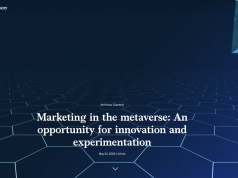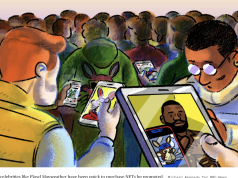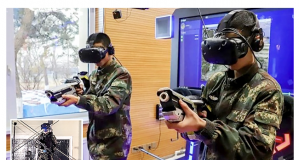Gartner Research, March 30, 2022. David Furlonger, Christophe Uzureau
New digital business models, the future of money and commerce are all driving the demand for and benefiting from NFTs — especially in fashion, art, sports, CPG, music and gaming industries. Three different strategies show executive leaders how NFTs can drive value for brands.
Overview
Key Findings
- NFT adoption is moving from digital art collectibles into mainstream product development.
- NFTs are exclusive artifacts created by programmable software that encode specific rights over, and uses for, the assets they represent, including restrictions on the number of NFTs issued for a given asset.
- NFT programmability enables asset fractionalization/fragmentation and targeting of unique business context, which increases investor access and reach (via fractionalization), changing the way capital is created and allocated.
Recommendations
Executive leaders responsible for digital business strategies to drive growth and increase brand value should:
- Improve the robustness of your digital business assets strategy by mapping the relationships between the drivers influencing adoption of NFTs. Leverage these relationships to promote portability of products and experience between physical and virtual environments.
- Monetize the online/offline world by using NFTs via product authentication and certification of assets.
- Encourage different purchasing behaviors and engagement experiences by using NFTs to program incentive mechanisms and influencing different purchasing behaviors and engagement experiences.
Introduction
New digital business models, the future of money and commerce are all driving the demand for and benefiting from NFTs, which can monetize all forms of assets and enhance provenance and authenticity in the transaction. Up to $41 billion worth of NFTs were traded in 2021.1,2Non-Fungible Token (NFT)An NFT is a blockchain-based monetized record of unique non interchangeable information that represents a piece of digital media. NFTs can link to any form of digital asset — digital art, text (such as a document), videos, photos, songs (or samples) or lines of code. NFTs can also represent, in a tokenized form, any digitally represented artifact, i.e., a physical asset that has been digitized.
Analysis
NFT adoption is moving from digital art collectibles into mainstream product development. A coherent strategy for engaging with NFT digital business assets (see Define and Map Cryptocurrencies, Digital Currencies and NFTs to Future-Proof Your Digital Transformation) is needed to drive the use of NFTs as part of customer engagement, product development and revenue generation. To build such a strategy it is critical to understand the relationships between the drivers influencing adoption of NFTs. Figure 1 shows a mapping of all the contributions of NFTs to digital transformation and value creation for enterprises.Figure 1. Map Showing How NFTs Accelerate Digital Transformation and Create Value for Companies

NFTs can enhance and monetize any form of asset (physical or digital), including digitalizing assets, monetizing intellectual property and creating an auditable path of authenticity for original assets and their creators. For example:
- NBA Top Shot3 highlighted that mainstream companies can generate a different level of engagement with their audience and monetize existing products and content — driving $821.3 million in sales as of December 2021.
- Infrastructure partner Dapper Labs is planning the same approach with the NFL.4
Clearly, companies can get value from using NFTs. The following sections describe the top three reasons.
NFTs Can Enforce Asset Exclusivity and Scarcity to Drive Brand and Product Value
NFTs are exclusive artifacts created by programmable software that encode specific rights over, and uses for, the assets they represent, including restrictions on the number of NFTs issued for a given asset (see Non-Fungible Tokens (NFTs) Create New Digital Products and Business Models). This drives value enhancement by:
- Assigning value and irrefutable ownership to otherwise indistinguishably replicable digital assets
- Transforming a physical asset into a digital one with its own properties and economic value streams
Using blockchain’s underlying technology provides wide-scale distribution of that exclusivity. Asset provenance, ownership and exchange of value via the use of smart contracts can be conducted via peer-to-peer (P2P). Examples include:
- Pringles CryptoCrisp is a limited 50-set edition NFT. Prices started at $2 and rose to $2,000.5
- Taco Bell’s taco GIFs is a limited set of 25 that sold out in 30 minutes and included a digital gift card worth $500.6
- The New York Times sold a column about NFTs to an NFT collector 3F Music for $560,000.7
- RTFKT (recently acquired by Nike) partnered with The Fabricant releasing “RenaiXance” in April 2021. An invitation-only collection with a sales time limit of 48 hours, 3,000 consumers subscribed on the first day and 213 NFT sold out in 11 minutes for between $22 and $10,820.8
However, while scarcity drives valuations it also encourages centralized platforms, big brands and now NFT whales to gain greater control and promote wash trading, which disguises true valuations. This activity can also disenfranchise core market constituents, for example, gamers9 (see Megamultinationals Are Redrawing the Rules of Geopolitics and Competition). According to Chainalysis, 9% of digital wallets held 80% of NFT value between February and November 2021.10
NFTs Can Monetize the Product Bridge Between Online and Offline Engagement
Crypto evangelists, gamers, influencers (physical and virtual11) and digitally native Gen Z consumers want to enhance their credibility and reputation. Doing so can improve across digital environments and their purchasing power via online interactions and the use of digital representations of physical things.NFT can monetize any kind of asset and therefore experience, including film clips, digital soccer cards, real estate, cars, art and gaming artifacts.This capability promotes portability of products and experience between physical and virtual environments. Startups such as Bloktopia, Decentraland, EXMO, Vega and others are trying to do just that for fashion, real estate, sports and the art industry. This creates multiple revenue opportunities:
- Brands can sell unique digital versions of physical products, in real time, while customer experiences are occurring, such as via metaverse interaction.
- Physical items can be accompanied by NFT certifications with embedded digital images of the physical item that can be traded online. The intellectual property (IP) and original physical item can remain the property of the initial creator for future collateral, rental, lease or sale.
- Secondary sales of NFT generates annuity revenue streams for creators/brands without diluting the original items value, for example, by incorporating metadata and streaming analytics.
- A digital item can become a physical item on the request of the NFT owner as illustrated by the forging process on the RTFKT platform12 (acquired by Nike).
- The use of new business models such as:
- Play-to-Earn (P2E) — increasing the value of in-game digital assets or generating fee revenue from those assets
- Experience-to-Earn (E2E) — rewarding customers for engaging with the brand, sharing ideas for campaigns
- Build-to-Earn (B2E) — recording customers’ contribution to a product design. For example, B2E could be the next stage on how Nike could use the RTFKT platform to enable co-creation of designs with customers.
- Rent-to-Earn (R2E) — renting NFTs to other customers, improving customer acquisition and deepening engagement. For example, the reNFT protocol enables participants to rent profile pictures for NFTs that are otherwise unaffordable or more highly recognizable.
Examples of monetization include:
- Vidy, a blockchain-based digital advertising firm, partnering with Vogue subsidiary Media Publishares,13 to launch an arts and culture NFT platform for a 360-degree virtual fashion experience. Content creators can monetize creativity directly via their “fans.”
- Sorare, a fantasy league game, enables users to build teams by collecting NFT of key players. Footballers can then limit image branding rights to just the physical world, while monetizing their digital personas.14
NFT also monetizes the online/offline world via product authentication and certification of assets, such as professional certifications, licenses, land titles, access rights and targeted programmable digital processes. A significant opportunity for some brands lies in their ability to use NFTs as an authenticator of authenticity and to weed out counterfeits and fraud thereby maintaining premiums over their products and pricing.
NFTs Can Drive Dynamic Programmability to Create New Revenue Streams
NFT programmability enables asset fractionalization/fragmentation and targeting of unique business context, which increases investor access and reach (via fractionalization), changing the way capital is created and allocated.NFT issuers can program incentive mechanisms to encourage different purchasing behaviors such as for sustainability in relation to recycling, the use of green energy credits, or for the reduction in product wastage, for example, in the fashion industry. This optimizes costs and promotes brand image. See Incentivize and Engage With Digital Tokens to Aid Recovery in a Reset COVID-19 World.NFT programmability also enables interactive brand experiences and the potential for an array of new digital products to be built by integrating art, design and digital business assets with social interaction capabilities and monetized experiences. Customers can be equipped with creative tools to engage them in highly interactive environments. For example, Dolce & Gabbana launched a physical/digital nine-piece fashion collection with marketplace UNXD, generating sales of $5.7 million.15In real time, purchasing behavior can be influenced via the application of specific advertising, data streaming, analytics, tokenization and trading, all within the same brand experience while it is occurring — physically or digitally. Online gaming is doing this via the development of “play-to-earn”16 games, such as Axie Infinity, Gods Unchained, Sorare, F1 Delta Time and Cometh (see Quick Answer: How to Increase Customer Engagement and Drive Revenue in the Metaverse).Generative NFTs such as CryptoPunks17 can also capture the creator’s vision translated into programmable components to generate unique art pieces or collectibles. This creative process has been very important to build communities and drive the underlying value of NFTs. Although the programmability of smart contracts offers great creative potential, they are attractive to bad actors who can exploit vulnerabilities in the code — business leaders should ensure that adequate security and process precautions are in place.Also, generative capabilities can inflame the existing multiplication (for example, via collections) of NFT which could have detrimental environmental consequences. Brands need to consider this carefully as part of reputation management and social engagement.
Evidence
1NFT Market Generated Over $23 Billion in Trading Volume in 2021, Forbes.2How NFTs Became a $40bn Market in 2021, Financial Times.3NBA Top Shot4NFL, NFLPA and Dapper Labs Announce New NFT Deal to Create Exclusive Digital Video Highlights, NFL News.5Pringles Virtual Flavor ‘CryptoCrisp’ Costs $800, FanSided.6The Brands Are at It Again — Taco Bell Is Hopping on the NFT Train, The Verge.7Crypto Token of New York Times Column Sells for $560,000, The New York Times.8Exclusive NFT Collection From RTFKT and THE FABRICANT Drops April 16th on THE DEMATERIALISED Marketspace, Yahoo Finance.9Final Fantasy XIV Players Show Their Rejection of Square Enix’s NFTs, Somag News.10How NFTs Became a $40bn Market in 2021, The Financial Times.11Olympic Winter Games Beijing 2022 – [Luo Tianyi], YouTube.12RTFKT13Media Publishares and Vidy to Launch NFT Platform for the Curation and Trade of Digital Fashion, Art and Music, Vogue.14Sorare15Dolce & Gabbana Just Set a $6 Million Record for Fashion NFTs, The New York Times. (Requires registration)16Play-to-Earn Gaming Is Driving NFT and Crypto Growth, Forbes.17CryptoPunks – How Do I Get a Punk, CryptoPunks.









